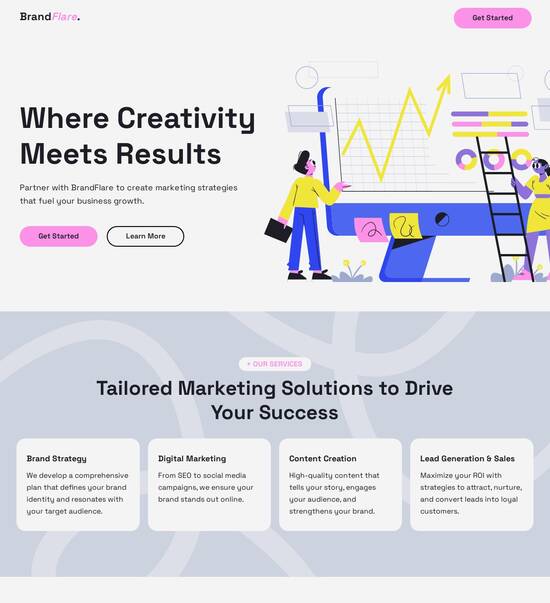
Scalable job portal template
Explore Similar TemplatesAbout template
Drive more leads with Instapage scalable job portal template built to maximize conversions. Easy customization - no designer or coding skills needed.
Recommended templates

Easy to build without coding
With the intuitive drag-and-drop builder, anyone on your team can create high-converting pages without any knowledge of code or design. Make enhancements to your landing page with custom widgets using Javascript, HTML/CSS, or third-party scripts.

Multiple layouts for any industry and goal
Select from 500+ landing page layouts built to boost conversions across industry-specific scenarios. Customize them by adjusting fonts, adding images, and generating on-brand content with the AI assistant. Quickly scale with Instablocks® and Global Blocks that you can save, reuse, and update globally.

Loads fast and looks polished on any device
Every template is responsive, which means they present professionally on any device and load blazingly fast with our Thor Render Engine. You can also power them up with Google AMP technology to deliver an unparalleled mobile experience and drive higher conversions.

Robust analytics & experimentation
Get real-time updates and reporting across all your devices, showing the number of visitors, conversions, cost-per-visitor, and cost-per-lead. Launch AI-powered experiments, run A/B tests, and use heatmaps to analyze user behavior, then optimize your landing page to maximize conversions.







Easy to build without coding
With the intuitive drag-and-drop builder, anyone on your team can create high-converting pages without any knowledge of code or design. Make enhancements to your landing page with custom widgets using Javascript, HTML/CSS, or third-party scripts.
Multiple layouts for any industry and goal
Select from 500+ landing page layouts built to boost conversions across industry-specific scenarios. Customize them by adjusting fonts, adding images, and generating on-brand content with the AI assistant. Quickly scale with Instablocks® and Global Blocks that you can save, reuse, and update globally.
Loads fast and looks polished on any device
Every template is responsive, which means they present professionally on any device and load blazingly fast with our Thor Render Engine.
Robust analytics & experimentation
Get real-time updates and reporting across all your devices, showing the number of visitors, conversions, cost-per-visitor, and cost-per-lead. Launch AI-powered experiments, run A/B tests, and use heatmaps to analyze user behavior, then optimize your landing page to maximize conversions.
All the features you need to build lead-generating landing pages
Explore more featuresLearn how to build top-performing landing pages for any goal
FAQs
Leading the way in building high-performing landing pages





Accelerate your marketing with Instapage's powerful landing page and CRO platform
In the competitive landscape of digital marketing, optimizing your campaigns is crucial for maximizing ROI. Instapage offers a comprehensive solution for marketers looking to create high-converting landing pages without any technical expertise. With over 100 high-quality templates and sophisticated collaboration tools, you can transform your marketing strategy and achieve your goals more efficiently.
Unlock the potential of landing pages
Creating effective landing pages is at the heart of successful digital marketing. Instapage’s intuitive platform allows users to build landing pages swiftly, utilizing a library of conversion-driven layouts and customizable elements. Here are a few key features that streamline this process:
- 100+ ready-to-use templates: Easily find designs tailored for various industries and objectives, allowing for rapid deployment.
- No coding required: The drag-and-drop functionality means anyone on your marketing team can create landing pages without needing programming skills.
- Instablocks: This feature enables you to save and reuse custom elements across multiple pages, ensuring brand consistency and time efficiency.
Optimize your campaigns with powerful tools
To ensure your landing pages yield optimal results, leveraging Instapage's built-in optimization tools is essential. The platform provides features that allow you to analyze and enhance performance effectively. Here are some tools to consider:
- A/B testing: Experiment with different elements on your landing pages to determine what combinations yield the best conversions.
- Heatmaps: Visualize on-page behavior to make informed decisions on layout adjustments and element placements.
- Analytics dashboard: Monitor key performance metrics to evaluate the success of your campaigns and tweak strategies as needed.
Personalize your marketing experience
The ability to personalize content is vital for engaging diverse audiences. Instapage offers powerful personalization features that help you tailor experiences based on audience segments. Key personalization capabilities include:
- Dynamic text replacement: Customize content dynamically based on referral information, ensuring your messaging resonates with each visitor.
- AdMappings: Align your specific ads with tailored landing pages to increase relevancy and conversion potential.
- Audience-level tracking: Analyze metrics specific to various audience segments, allowing for targeted adjustments in future campaigns.
Embracing these strategies on the Instapage platform can significantly enhance the effectiveness of your digital marketing efforts.
As you explore the vast features available on Instapage, remember that every tool is designed to simplify your workflow and amplify your results.
Ready to elevate your digital marketing campaigns? Start using Instapage today to take full advantage of its powerful landing page solutions and watch your ROI soar!
People also ask about Scalable job portal template
Unveiling the Power of Scalable Job Portal Templates
Understanding the job portal ecosystem
Job portals have become essential components of the employment landscape, serving as platforms where job seekers and employers connect. They streamline the application process, making it more accessible and efficient for both parties. From their humble beginnings as simple classified ads, job portals have transformed into multifaceted digital ecosystems that facilitate various recruitment processes. This evolution has shifted how we think about job searching and hiring, emphasizing the need for more sophisticated solutions.
The demand for scalable solutions in this sector has surged, driven by an increasingly competitive job market. With a growing number of job applications and varying employer needs, portals must be designed to accommodate higher traffic and additional functionalities. Scalability is crucial, allowing platforms to expand or modify their capabilities as the business landscape changes. This aligns job portals more closely with the realities of dynamic employment trends, ensuring that they remain relevant and effective.
Key features of a job portal website template
A successful job portal template is designed with numerous features that enhance usability and efficiency. Responsive design principles are paramount, ensuring that the portal offers an optimal viewing experience across various devices, whether mobile or desktop. This flexibility allows job seekers to search and apply for jobs wherever they are, leading to greater accessibility and satisfaction.
Responsive layouts that adapt to screen sizes seamlessly.
Advanced filtering options that help users find specific job types.
Intuitive navigation to facilitate easy searching and browsing.
Further, comprehensive job listing capabilities enhance user engagement. Advanced search and filtering tools allow job seekers to narrow down listings based on specific criteria such as location, salary, and industry. The integration of job categories and tags simplifies navigation, making it easier for users to find relevant positions. A user-friendly dashboard for both job seekers and employers enhances the overall experience, providing intuitive access to profiles, applications, and communications.
Innovative functionality: What sets scalable job portal templates apart
Scalable job portal templates come equipped with innovative functionalities that distinguish them from standard offerings. Enhanced SEO features are crucial, as they significantly improve a portal’s visibility in search engines. This is vital in attracting both job seekers and employers to the platform. Specific SEO strategies embedded within the template can include customized metadata, optimized images, and structured data to boost search rankings.
Utilization of targeted keywords throughout job postings.
Clean URLs that are easy for search engines to crawl.
Integration of social media sharing features to extend reach.
Adaptive business header templates enhance brand identity while fostering user trust and engagement. A customizable header reflects company branding, allowing organizations to create a cohesive online presence. This professionalism can significantly impact user perceptions, making them more likely to engage with the platform. Additionally, integrated analytics and reporting tools provide insights into user behavior, tracking job postings and engagement metrics, which can refine service offerings and improve user experience.
Customization and flexibility: Tailoring the job portal to your needs
Customization is a core tenet of scalable job portal templates. A modular template design allows users to modify elements according to their specific needs, offering flexibility that caters to various business sizes and types. This ensures platforms can adapt as their requirements evolve, whether adding new features or rebranding to meet customer expectations.
Easily adjustable modules for job listings, profiles, and applications.
Options for unique layout designs that align with company aesthetics.
Settings for configuring notifications and alerts for users.
Furthermore, industry-specific designs allow for tailored solutions that cater to diverse sectors, such as tech, healthcare, or education. These templates facilitate targeted job offerings, attracting both relevant job seekers and employers. For instance, a tech-centric portal might highlight programming languages or skills relevant to the sector, making it more appealing to candidate profiles.
Streamlining operations: Essential services built into job portal templates
Operating a job portal comes with several logistical challenges, and scalable templates can streamline many of these operations. Job posting and application management features simplify the job listing creation process, enabling employers to publish openings quickly and efficiently. These functionalities often come built-in with applicant tracking systems, allowing employers to manage applications seamlessly and streamline recruitment.
Simplified workflows for posting new jobs and managing applications.
Automated notifications to keep candidates informed throughout the hiring process.
Easy collaboration tools for hiring teams to review applicants.
Additionally, integrated payment gateway functionality allows for seamless transactions for premium listings. This feature ensures a secure environment for monetary exchanges and can encompass compliance with regulatory standards. Employing this functionality can significantly enhance job portal revenue models while improving user trust in the platform.
Development insights: Creating a dynamic job portal website
Building a job portal website efficiently requires careful consideration of the technology stack used. Choosing the right programming languages and frameworks is essential, with scalable technologies playing a critical role in accommodating future growth. Developers often prefer languages like JavaScript or Python for their versatility and the thriving ecosystems that support modern web development.
JavaScript frameworks like React or Vue.js for interactive user interfaces.
Back-end frameworks like Django or Node.js for robust server-side logic.
Database solutions like PostgreSQL or MongoDB for data storage.
User experience (UX) is a pivotal focus in website design, particularly for job portals. Following UX design principles can significantly affect user retention and satisfaction. Practical case studies illustrate effective UX implementations that increase engagement. For example, a well-structured application process with clear instructions can minimize drop-off rates, ensuring that candidates complete their applications.
The role of demos in showcasing job portal capabilities
Live demonstrations are invaluable for potential users exploring a job portal template’s functionalities. Demos allow stakeholders to visualize and interact with features in real-time, which can enhance their understanding of the product’s capabilities. Creating effective demo environments that accurately reflect the final user experience is crucial for convincing potential customers.
Incorporate all essential functionalities to showcase the template's full potential.
Offer guided walkthroughs to explain features and benefits.
Collect user feedback during demos to refine offerings.
Engaging potential clients through interactive features in demo versions can further enhance the likelihood of conversion. For instance, allowing users to post mock job listings or navigate through a simulated application process showcases the template's usability directly, making the demonstration much more impactful.
Marketing your job portal: Tools and techniques
To effectively market a job portal, an understanding of SEO strategies tailored for startups is essential. New job portals must focus on SEO best practices that facilitate visibility, such as keyword optimization, content marketing, and backlink building. Local SEO should also be a focus, as regional talent searches often yield better results for localized businesses or industries.
Conduct keyword research specific to your target audience.
Create localized content that addresses regional job market needs.
Build relationships with local institutions for backlinking opportunities.
Leveraging social media also plays a substantial role in brand growth. Proactive social media strategies for promoting job listings enhance visibility and engagement. Building an online community around discussions relevant to the industry fosters interaction and growth, further solidifying the job portal's presence in the market.
Calculating costs and benefits of implementing a job portal template
Evaluating the costs and benefits of a job portal is crucial for determining ROI. Analyzing expenses versus potential income generated from job listings can yield valuable insights. Elements such as the implementation costs, ongoing maintenance, and marketing efforts should be weighed against the expected revenue from paid listings or featured employer slots.
Estimate initial setup and customization costs.
Consider subscription fees for hosting and third-party integrations.
Project potential income based on targeted job listing traffic.
Examining case studies of successful job portals that have utilized scalable templates reveals practical approaches and lessons learned. Reviewing how others have navigated challenges can provide insights and inspiration for potential job portal developers.
Future trends in job portal development and scalability
The future of job portals is anticipated to be heavily influenced by advancements in artificial intelligence and machine learning. These technologies are beginning to transform how job matching occurs, leveraging user data to deliver tailored job recommendations. The integration of AI could enhance user engagement by providing personalized experiences that anticipate user needs and preferences, which is essential in a crowded job market.
Automated resume parsing systems to simplify application management.
Chatbots to assist users with inquiries in real-time.
Predictive analytics for understanding job market trends.
Moreover, adapting to remote work trends is prompting new designs and functionalities in job portals. Templates that cater specifically to remote job markets will likely flourish, offering features such as virtual interviews or remote work culture insights. Embracing this flexibility will enable job portals to maintain relevance and effectively serve the shifting needs of job seekers and employers alike.
Ready to skyrocket conversions?
Supercharge your ad campaigns with high-performing landing pages
Get started














